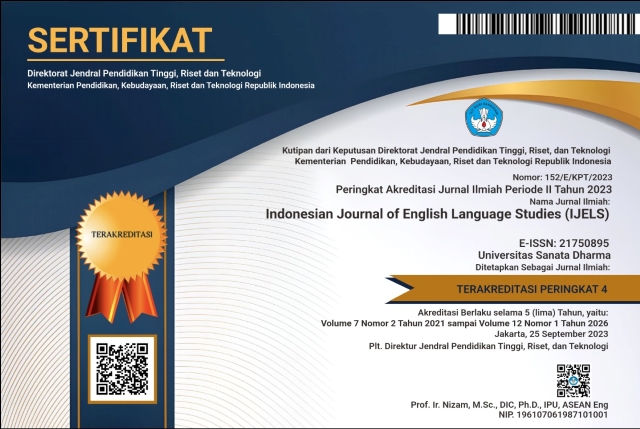Construal of English Prepositions in, on, and at
(1)
(*) Corresponding Author
Abstract
The use of English preposition is a little bit confusing, especially for Indonesians. It is because Indonesia only has one preposition di- to indicate the English prepositions in, on, and at. In this research, it is found that the prepositions in, on, and at are used differently based on the relation between the object and the landmark. For preposition in, the concept of containment is introduced. This preposition is used when the object is surrounded by the landmark. For preposition on, the concept of contact and support is highlighted, and gravity takes part in the use of this preposition. It means that the object should be in contact with the landmark and the landmark should support the object so that it will not move or fall. Lastly, the preposition at requires us to portray an imaginary location to determine a certain point of the object. By using the correct preposition in, on, and at, one can have linguistic knowledge, and be able to avoid ambiguity to convey correct messages or ideas to the interlocutors.
Keywords
Full Text:
PDFReferences
Conventry, K. R., & Garrod, S. (2004). Saying, seeing, and acting: The psychological semantics of spatial prepositions essays in cognitive psychology. East Sussex: Psychology Press.
Cuyckens, H. (1994). The Dutch spatial preposition "in": A cognitive- semantic analysis. In C. Zelinsky- Wibbelt (Ed.), The semantics of prepositions: From mental processing to natural language processing (pp. 27-72). Berlin: Mouton de Gruyter.
Dirven, R. (1994). Dividing up physical and mental space into conceptual categories by means of English prepositions. In C.
Zelinsky- Wibbelt (Ed.), The semantics of prepositions: From mental processing to natural language processing (pp. 73-98). Berlin: Mouton de Gruyter.
Hatim, B., & Munday, J. (2004). Translation: An advanced resource book. Oxon: Routledge.
Hottenroth, P.-M. (1994). Prepositions and object concepts: A contribution to cognitive semantics. In C. Zelinsky- Wibbelt (Ed.), The semantics of prepositions: From mental processing to natural language processing (pp. 179-220). Berlin: Mouton de Gruyter.
Kaufman, I. (1994). Semantic and conceptual aspects of the preposition durch. In C. Zelinsky- Wibbelt (Ed.), The semantics of prepositions: From mental processing to natural language processing (pp. 221-248). Berlin: Mouton de Gruyter.
Lang, E. (1994). The meaning of German projective prepositions: A two-level approach. In C. Zelinsky-Wibbelt (Ed.), The semantics of prepositions: From mental processing to natural language processing (pp. 249-294). Berlin: Mouton de Gruyter.
Lindstromberg, S. (2010). English preposition explained (Revised ed.). Amsterdam: John Benjamin Publishing Company.
Radden, G., & Dirven, R. (2007). Cognitive English grammar: Cognitive linguistics in practice (Vol. 2). Amsterdam: John Benjamins Publishing Company.
Rambaud, M. G. (2012). Basic Semantics. Madrid: Universidad Nacional de Educación a Distancia. Retrieved from www.uned.es/publicaciones
Tyler, A., & Evans, V. (2003). The semantics of English prepositions: Spatial scenes, embodied meaning, and cognition. New York: Cambridge University Press.
Zelinsky-Wibbelt, C. (1994). Interpreting and translating prepositions: A conitively based formalization. In C. Zelinsky-Wibbelt (Ed.), The semantics of prepositions: From mental processing to natural language processing (pp. 351-390). Berlin: Mouton de Gruyter.
Zelinsky-Wibbelt, C. (1994). Introduction. In C. Zelinsky-Wibbelt (Ed.), The semantics of prepositions: From mental processing to natural language processing (pp. 1-26).
Berlin: Mouton de Gruyter.
DOI: https://doi.org/10.24071/ijels.v4i2.2306
Refbacks
- There are currently no refbacks.

This work is licensed under a Creative Commons Attribution-ShareAlike 4.0 International License.
IJELS Journal Sinta 4 Certificate (S4 = Level 4)
We would like to inform you that Indonesian Journal of English Language Studies (IJELS) has been nationally accredited Sinta 4 by the Ministry of Education, Culture, Research and Technology of the Republic of Indonesia based on the decree No. Surat Keputusan 152/E/KPT/2023. Validity for 5 years: Vol 7 No 2, 2021 till Vol 12 No 1, 2026

This work is licensed under CC BY-SA.
Creative Commons Attribution-ShareAlike 4.0 International License
IJELS e-ISSN 2715-0895; IJELS p-ISSN 2442-790X
Indonesian Journal of English Language Studies (IJELS) is published twice a year, namely in March and September, by the English Language Studies (ELS) of the Graduate Program of Sanata Dharma University, Yogyakarta, Indonesia.


 IJELS p-ISSN:
IJELS p-ISSN: 









